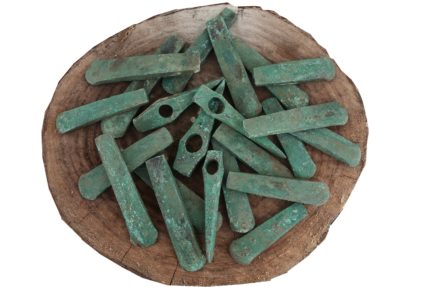A hoard of Copper Age axes and ax hammers discovered in Bulgaria is the largest ever found in Europe. The heavy copper tools were found accidentally during agricultural work near the village of Polkovnik Taslakovo in the northeastern region of Silistra in 2013. The 22 pieces — 18 flat axes and four axe hammers — were found together in one spot about three feet below the surface. The farmer, Erdoan Ismet Shaban, alerted the authorities and experts from the Ruse Regional Museum of History were dispatched to examine the hoard.
The tools are made of an alloy with a high copper content for a total weight of 25.6 pounds. They date to the late Chalcolithic, 4500-4200 B.C., a time when the site was on the periphery of the highly populated and metallurgically active settlements on the coast of the Black Sea. It’s likely that the tools in the hoard were cast in one of those places, in fact, and then traded and distributed west to central Bulgaria and other parts of the Balkan Peninsula. There are four settlement mounds near the find site, so it’s possible the hoard was connected to one of them, but there has been no archaeological field survey of the area to help determine whether there is a Chalcolithic layer that can be associated with the find.
“The discovered find is the largest [of its kind] in Europe so far. It is a testimony to the [development and sophistication] of the earliest metallurgy in human history,” the Ruse Regional Museum of History says.
“The axes bear hardly any traces that they were used which leads to the supposition that they were not meant for practical purposes but were an indicator of prestige, or were [were used as] means of exchange,” the Museum adds.
The axes and axe hammers are now on display at the Regional Museum of History in Silistra where they will be conserved and stored in proper conditions.

Those Bronze Age axe deposits are (maybe quite not so) quite common in central Europe, and Germany.
Immediately, I had one in mind from Lebus (state of Brandenburg), where a whopping 22 kilograms had been found, consisting of 103 copper axes, 2 rings, only fragments of a sword and a bit of ‘leftover bronze’ (cf.: ‘Bronzehort vom Burgberg Lebus’).
Thus, I am not convinced that 22 copper axes would really count as ‘Europe’s largest hoard of copper axes’ 🙂
—-
OK, the ones presented here, are seemingly from a quite early Bronze Age.
Another possibility is that the axes were manufactured for practical use, but never employed.
Could be these were a merchant/trader’s inventory that was buried because of unrest or loss of a pack animal. I think the archeologists are too quick to label something as ceremonial when they don’t have context to reliably attribute it to that.
from what I read, this is much earlier than Bronze Age…I would assume that is why these are copper
“an alloy with a high copper content”: but what is the copper alloyed with?
If the alloy has much the same physical properties as copper, would it make a decent axe? For what purpose would it be better than a stone axe?
“be conserved and stored in proper conditions.’.
Are they going to rebuy them? They don’t appear to need any conserving at all to me. I guess anything that creates a job ….
Whenever I read these and the expert tells their idea of why the items were found that way, I always imagine a historical novel where something completely different took place.